Novel Bilayer Micropyramid Structure Photonic Nanojet for Enhancing a Focused Optical Field
Abstract
:1. Introduction
2. Materials and Methods
2.1. Theory and Design
2.2. Modeling Methods
2.3. Fabrication of the Bilayer Micropyramid Array
2.4. Measurement Setup
3. Results and Discussion
3.1. Manufacturing Results
3.2. Characterization of the Focusing Properties
4. Conclusions
Author Contributions
Funding
Data Availability Statement
Conflicts of Interest
References
- Ren, Y.; Zhao, L.; Zou, Y.; Song, L.; Dong, N.; Wang, J. Effects of different TiO2 particle sizes on the microstructure and optical limiting properties of TiO2/Reduced graphene oxide nanocomposites. Nanomaterials 2019, 9, 730. [Google Scholar] [CrossRef] [Green Version]
- Guo, Z.; Xu, H.; Guo, K.; Shen, F.; Zhou, H.; Zhou, Q.; Gao, J.; Yin, Z. High-Efficiency visible transmitting polarizations devices based on the GaN metasurface. Nanomaterials 2018, 8, 333. [Google Scholar] [CrossRef] [PubMed] [Green Version]
- Huang, H.; Li, Q.; Fu, J.; Wu, J.; Lin, F.; Wu, X. Efficient subwavelength focusing of light with a long focal depth. Nanoscale 2015, 7, 16504–16507. [Google Scholar] [CrossRef] [PubMed]
- Chen, Z.; Taflove, A.; Backman, V. Photonic nanojet enhancement of backscattering of light by nanoparticles: A potential novel visible-light ultramicroscopy technique. Opt. Express 2004, 12, 1214–1220. [Google Scholar] [CrossRef]
- Horiuchi, N. Photonic nanojets. Nat. Photonics 2012, 6, 138–139. [Google Scholar] [CrossRef]
- Yue, L.; Yan, B.; Wang, Z. Photonic nanojet of cylindrical metalens assembled by hexagonally arranged nanofibers for breaking the diffraction limit. Opt. Lett. 2016, 41, 1336–1339. [Google Scholar] [CrossRef]
- Zhen, Z.; Huang, Y.; Feng, Y.; Shen, Y.; Li, Z. An ultranarrow photonic nanojet formed by an engineered two-layer microcylinder of high refractive-index materials. Opt. Express 2019, 27, 9178–9188. [Google Scholar] [CrossRef]
- Shen, Y.; Wang, L.V.; Shen, J.-T. Ultralong photonic nanojet formed by a two-layer dielectric microsphere. Opt. Lett. 2014, 39, 4120–4123. [Google Scholar] [CrossRef] [PubMed] [Green Version]
- Gu, G.; Zhou, R.; Chen, Z.; Xu, H.; Cai, G.; Cai, Z.; Hong, M. Super-long photonic nanojet generated from liquid-filled hollow microcylinder. Opt. Lett. 2015, 40, 625–628. [Google Scholar] [CrossRef]
- Matsui, T.; Tsukuda, K. Direct imaging of tunable photonic nanojets from a self-assembled liquid crystal microdroplet. Opt. Lett. 2017, 42, 4663–4666. [Google Scholar] [CrossRef]
- Du, B.; Xia, J.; Wu, J.; Zhao, J.; Zhang, H. Switchable photonic nanojet by electro-switching nematic liquid crystals. Nanomaterials 2019, 9, 72. [Google Scholar] [CrossRef] [PubMed] [Green Version]
- Jacassi, A.; Tantussi, F.; Dipalo, M.; Biagini, C.; Maccaferri, N.; Bozzola, A.; De Angelis, F. Scanning Probe Photonic Nanojet Lithography. ACS Appl. Mater. Interfaces 2017, 9, 32386–32393. [Google Scholar] [CrossRef] [PubMed] [Green Version]
- Wen, Y.; Yu, H.; Zhao, W.; Wang, F.; Wang, X.; Liu, L.; Li, W.J. Photonic nanojet sub-diffraction nano-fabrication with in situ Super-Resolution Imaging. IEEE Trans. Nanotechnol. 2019, 18, 226–233. [Google Scholar] [CrossRef]
- Yan, Y.; Li, L.; Feng, C.; Guo, W.; Lee, S.; Hong, M. Microsphere-coupled scanning laser confocal nanoscope for sub-diffraction-limited imaging at 25 nm lateral resolution in the visible spectrum. ACS Nano 2014, 8, 1809–1816. [Google Scholar] [CrossRef]
- Yang, H.; Trouillon, R.; Huszka, G.; Gijs, M.A. Super-Resolution imaging of a dielectric microsphere is governed by the waist of its photonic nanojet. Nano Lett. 2016, 16, 4862–4870. [Google Scholar] [CrossRef]
- Born, B.; Krupa, J.D.A.; Geoffroy-Gagnon, S.; Holzman, J.F. Integration of photonic nanojets and semiconductor nanoparticles for enhanced all-optical switching. Nat. Commun. 2015, 6, 8097. [Google Scholar] [CrossRef]
- Born, B.; Geoffroy-Gagnon, S.; Krupa, J.D.A.; Hristovski, I.R.; Collier, C.M.; Holzman, J.F. Ultrafast all-optical switching via subdiffractional photonic nanojets and select semiconductor nanoparticles. ACS Photonics 2016, 3, 1095–1101. [Google Scholar] [CrossRef] [Green Version]
- Maragò, O.M.; Jones, P.H.; Gucciardi, P.G.; Volpe, G.; Ferrari, A.C. Optical trapping and manipulation of nanostructures. Nat. Nanotechnol. 2013, 8, 807–819. [Google Scholar] [CrossRef] [Green Version]
- Li, Y.; Xin, H.; Liu, X.; Zhang, Y.; Lei, H.; Li, B. Trapping and detection of nanoparticles and cells using a parallel photonic nanojet array. ACS Nano 2016, 10, 5800–5808. [Google Scholar] [CrossRef]
- Li, Y.-C.; Xin, H.-B.; Lei, H.-X.; Liu, L.-L.; Li, Y.-Z.; Zhang, Y.; Li, B.-J. Manipulation and detection of single nanoparticles and biomolecules by a photonic nanojet. Light Sci. Appl. 2016, 5, e16176. [Google Scholar] [CrossRef]
- Luk’yanchuk, B.S.; Paniagua-Domínguez, R.; Minin, I.; Minin, O.; Wang, Z. Refractive index less than two: Photonic nanojets yesterday, today and tomorrow [Invited]. Opt. Mater. Express 2017, 7, 1820–1847. [Google Scholar] [CrossRef]
- Minin, I.V.; Minin, O.V. Diffractive Optics and Nanophotonics, 1st ed.; Springer International Publishings: Cham, Switzerland, 2016; pp. 978–983. [Google Scholar]
- Hou, J.; Yao, L.; Ren, J.; Guo, M.; Ye, Y.H. Magnification and resolution of microlenses with different shapes. Micro Nano Lett. 2015, 10, 351–354. [Google Scholar] [CrossRef]
- Li, X.; Chen, Z.; Taflove, A.; Backman, V. Optical analysis of nanoparticles via enhanced backscattering facilitated by 3-D photonic nanojets. Opt. Express 2005, 13, 526–533. [Google Scholar] [CrossRef] [Green Version]
- Minin, I.V.; Geints, Y.E.; Zemlyanov, A.A.; Minin, O.V. Specular-reflection photonic nanojet: Physical basis and optical trapping application. Opt. Express 2020, 28, 22690–22704. [Google Scholar] [CrossRef] [PubMed]
- Li, Y.; Liu, X.; Xu, X.; Xin, H.; Zhang, Y.; Li, B. Red-blood-cell waveguide as a living biosensor and micromotor. Adv. Funct. Mater. 2019, 29, 1905568. [Google Scholar] [CrossRef]
- Rockstuhl, C.; Simovski, C.R.; Tretyakov, S.A.; Lederer, F. Metamaterial nanotips. Appl. Phys. Lett. 2009, 94, 113110. [Google Scholar] [CrossRef]
- Minin, I.V.; Minin, O.V.; Geints, Y.E. Localized EM and photonic jets from non-spherical and non-symmetrical dielectric mesoscale objects: Brief review. Ann. Der Phys. 2015, 527, 491–497. [Google Scholar] [CrossRef] [Green Version]
- Nguyen, H.H.; Hisatake, S.; Minin, I.V.; Minin, O.V.; Nagatsuma, T. Three-dimensional direct observation of Gouy phase shift in a terajet produced by a dielectric cuboid. Appl. Phys. Lett. 2016, 108, 191102. [Google Scholar] [CrossRef]
- Zhu, J.; Goddard, L.L. All-dielectric concentration of electromagnetic fields at the nanoscale: The role of photonic nanojets. Nanoscale Adv. 2019, 1, 4615–4643. [Google Scholar] [CrossRef] [Green Version]
- Minin, I.V.; Minin, O.V. Photonics of isolated dielectric particles of arbitrary 3D shape-a new direction of optical information technologies. Vestn. NSU 2014, 12, 59–70. [Google Scholar]
- Geints, Y.E.; Zemlyanov, A.A.; Panina, E.K. Microaxicon-generated photonic nanojets. J. Opt. Soc. Am. B 2015, 32, 1570–1574. [Google Scholar] [CrossRef]
- Nayak, C.; Mukharjee, S.; Saha, A. Process engineering study of photonic nanojet from highly intense to higher propagation using FDTD method. Optik 2016, 127, 8836–8840. [Google Scholar] [CrossRef]
- Geints, Y.E.; Zemlyanov, A.A.; Minin, O.V.; Minin, I.V. Systematic study and comparison of photonic nanojets produced by dielectric microparticles in 2D-and 3D-spatial configurations. J. Opt. 2018, 20, 065606. [Google Scholar] [CrossRef]
- Geints, Y.E.; Panina, E.K.; Zemlyanov, A.A. Comparative analysis of key parameters of photonic nanojets from axisymmetric nonspherical microparticles. Atmos. Ocean. Opt. 2019, 32, 41–44. [Google Scholar] [CrossRef]
- Minin, I.V.; Shuvalov, G.V.; Minin, O.V. All-dielectric asymmetrical metasurfaces based on mesoscale dielectric particles with different optical transmissions in opposite directions through full internal reflection. In Frontier Research and Innovation in Optoelectronics Technology and Industry; CRC Press: Kunming, China, 2018; pp. 437–440. [Google Scholar]
- Liu, C.-Y.; Minin, O.V.; Minin, I.V. First experimental observation of array of photonic jets from saw-tooth phase diffraction grating. EPL (Europhys. Lett.) 2018, 123, 54003. [Google Scholar] [CrossRef]
- Kao, K.C.; Hockham, G.A. Dielectric-fibre surface waveguides for optical frequencies. Inst. Electr. Eng. 1966, 113, 1151–1158. [Google Scholar] [CrossRef] [Green Version]
- Barr, L.E.; Karlsen, P.; Hornett, S.M.; Hooper, I.R.; Mrnka, M.; Lawrence, C.R.; David, B.P.; Hendry, E. Super-resolution imaging for sub-IR frequencies based on total internal reflection. Optica 2021, 8, 88–94. [Google Scholar] [CrossRef]
- Liu, X.; Parrott, E.P.J.; Ung, B.S.-Y.; Pickwell-MacPherson, E. Exploiting total internal reflection geometry for efficient optical modulation of terahertz light. APL Photonics 2016, 1, 076103. [Google Scholar] [CrossRef] [Green Version]
- Zhang, C.; Li, D.; Zhu, H.; Li, C.; Jiao, Z.; Wang, N.; Xu, Z.; Wang, X.; Song, L. A study on suppressing transmittance fluctuations for air-gapped Glan-type polarizing prisms. Opt. Commun. 2018, 414, 106–112. [Google Scholar] [CrossRef]
- Axelrod, D. Total Internal Reflection Fluorescence Microscopy in Cell Biology. Traffic 2001, 2, 764–774. [Google Scholar] [CrossRef] [PubMed]
- Tao, Y.; Li, S.; Liu, S. Analysis and Improvement of Frequency Stabilization Characteristics of a Total Reflection Prism Laser Gyro. IEEE Access 2018, 6, 69185–69194. [Google Scholar] [CrossRef]
- Born, M.; Wolf, E. Principles of Optics: Electromagnetic Theory of Propagation, Interference and Diffraction of Light, 7th ed.; Elsevier: Amsterdam, The Netherlands, 2013; pp. 154–196. [Google Scholar]
- Ge, S.; Liu, W.; Zhou, S.; Li, S.; Sun, X.; Huang, Y.; Yang, P.; Zhang, J.; Lin, D. Design and preparation of a micropyramid structured thin film for broadband infrared antireflection. Coatings 2018, 8, 192. [Google Scholar] [CrossRef] [Green Version]
- Kong, S.-C.; Taflove, A.; Backman, V. Quasi one-dimensional light beam generated by a graded-index microsphere. Opt. Express 2009, 17, 3722–3731. [Google Scholar] [CrossRef] [Green Version]
- Gu, G.; Zhang, P.; Chen, S.; Zhang, Y.; Yang, H. Inflection point: A perspective on photonic nanojets. Photonics Res. 2021, 9, 1157–1171. [Google Scholar] [CrossRef]
- Yu, Y.; Li, W.; Li, H.; Li, M.; Yuan, W. An Investigation of influencing factors on practical sub-diffraction-limit focusing of planar super-oscillation lenses. Nanomaterials 2018, 8, 185. [Google Scholar] [CrossRef] [PubMed] [Green Version]
- Minin, I.V.; Minin, O.V.; Yue, L. Electromagnetic properties of pyramids from positions of photonics. Russ. Phys. J. 2020, 62, 1763–1769. [Google Scholar] [CrossRef]
- Gao, J.; Wang, C.; Qiang, T.; Zhang, K.; Wu, Q. Multifunctional polarization converter based on dielectric metamaterial. Phys. Status Solidi A 2018, 215, 1700535. [Google Scholar] [CrossRef]
- Balezin, M.; Baryshnikova, K.V.; Kapitanova, P.; Evlyukhin, A.B. Electromagnetic properties of the Great Pyramid: First multipole resonances and energy concentration. J. Appl. Phys. 2018, 124, 034903. [Google Scholar] [CrossRef]
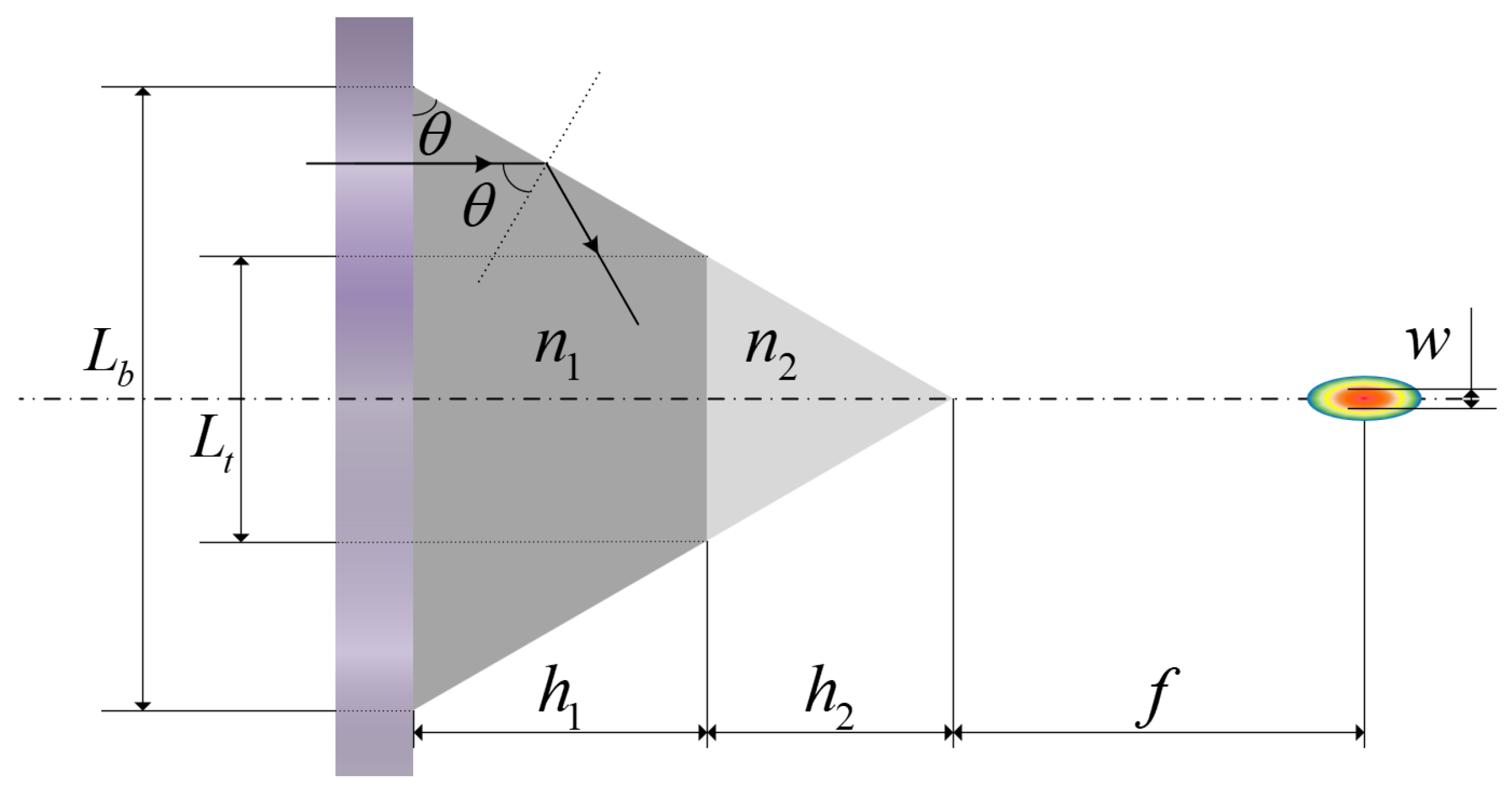
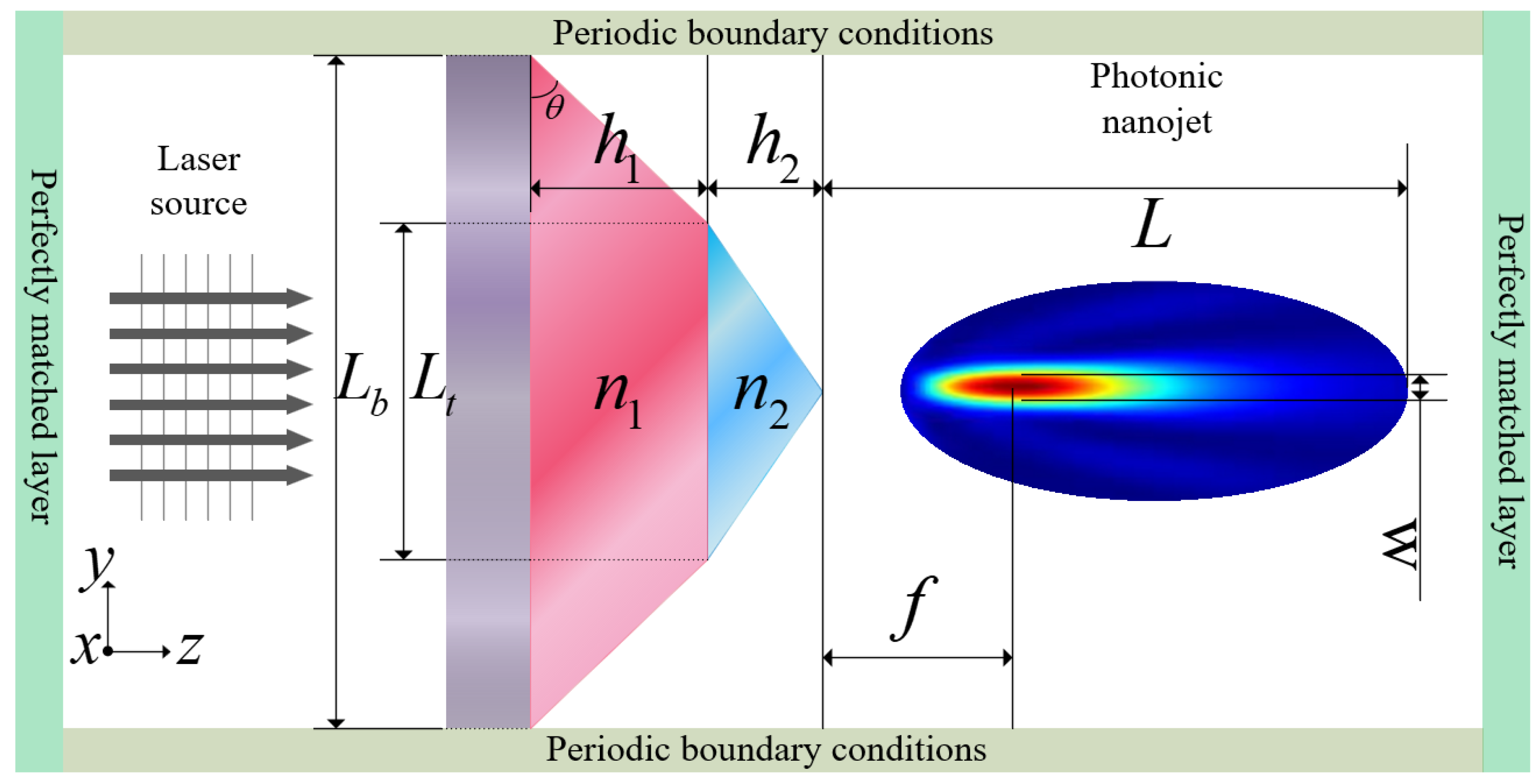

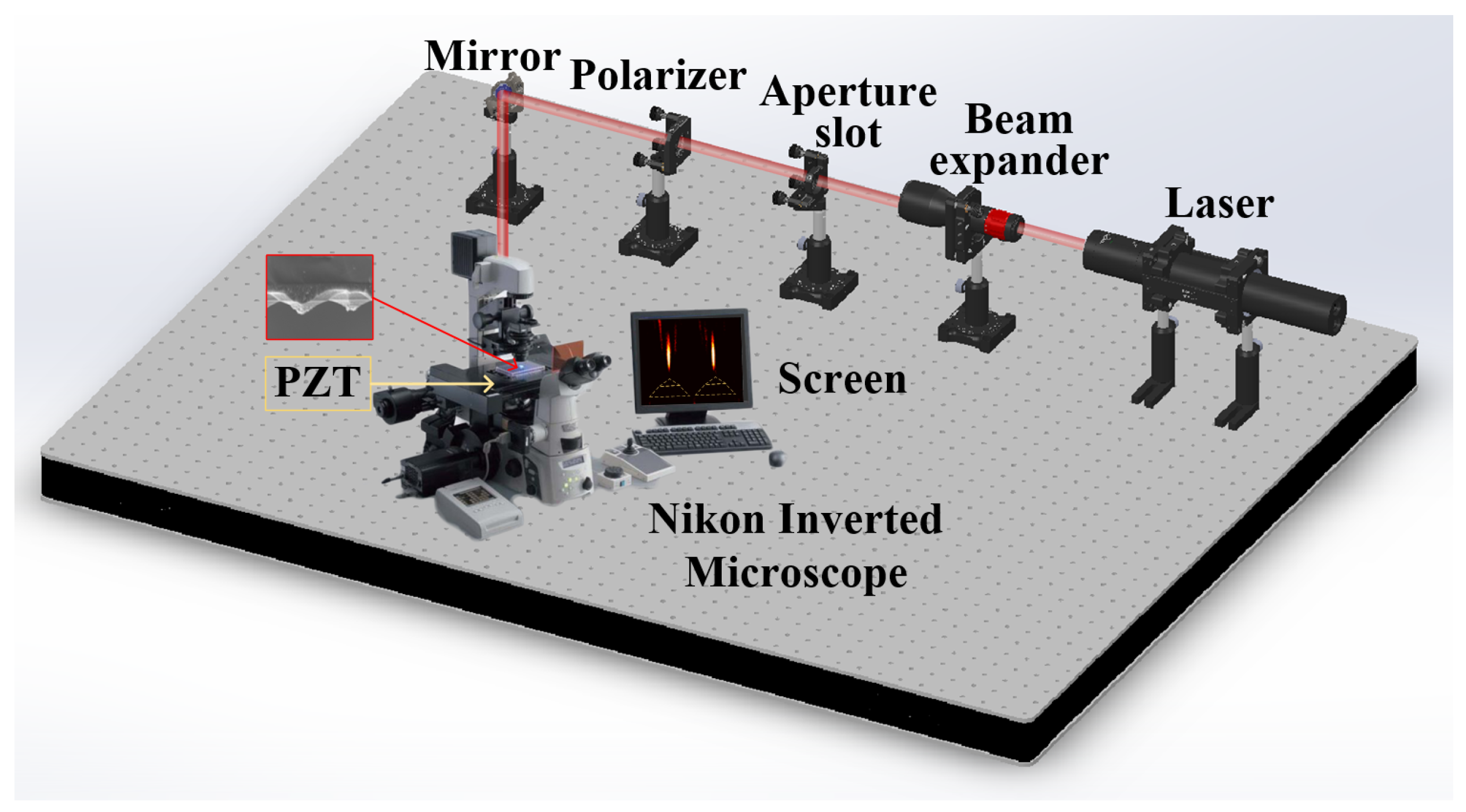

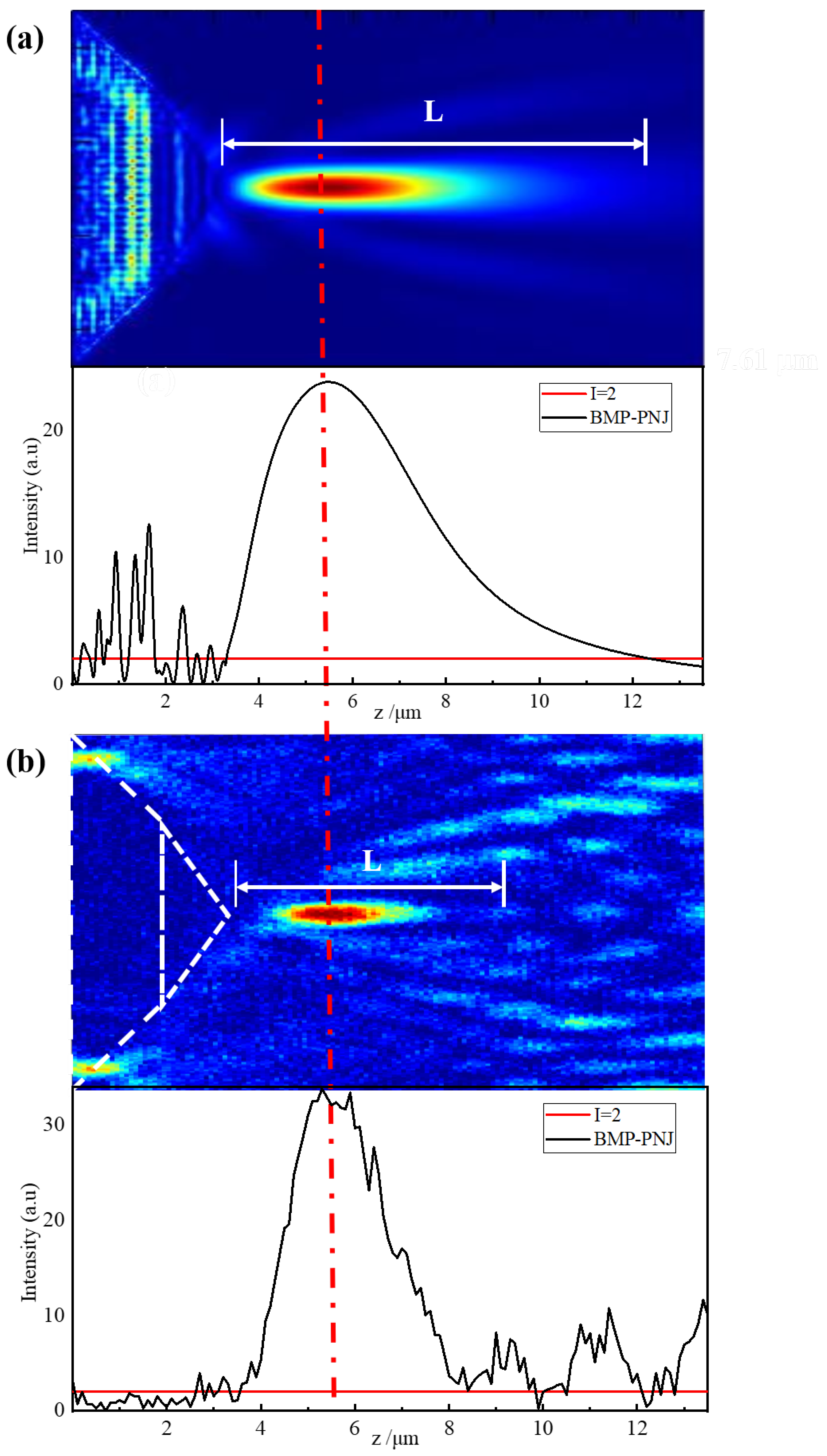
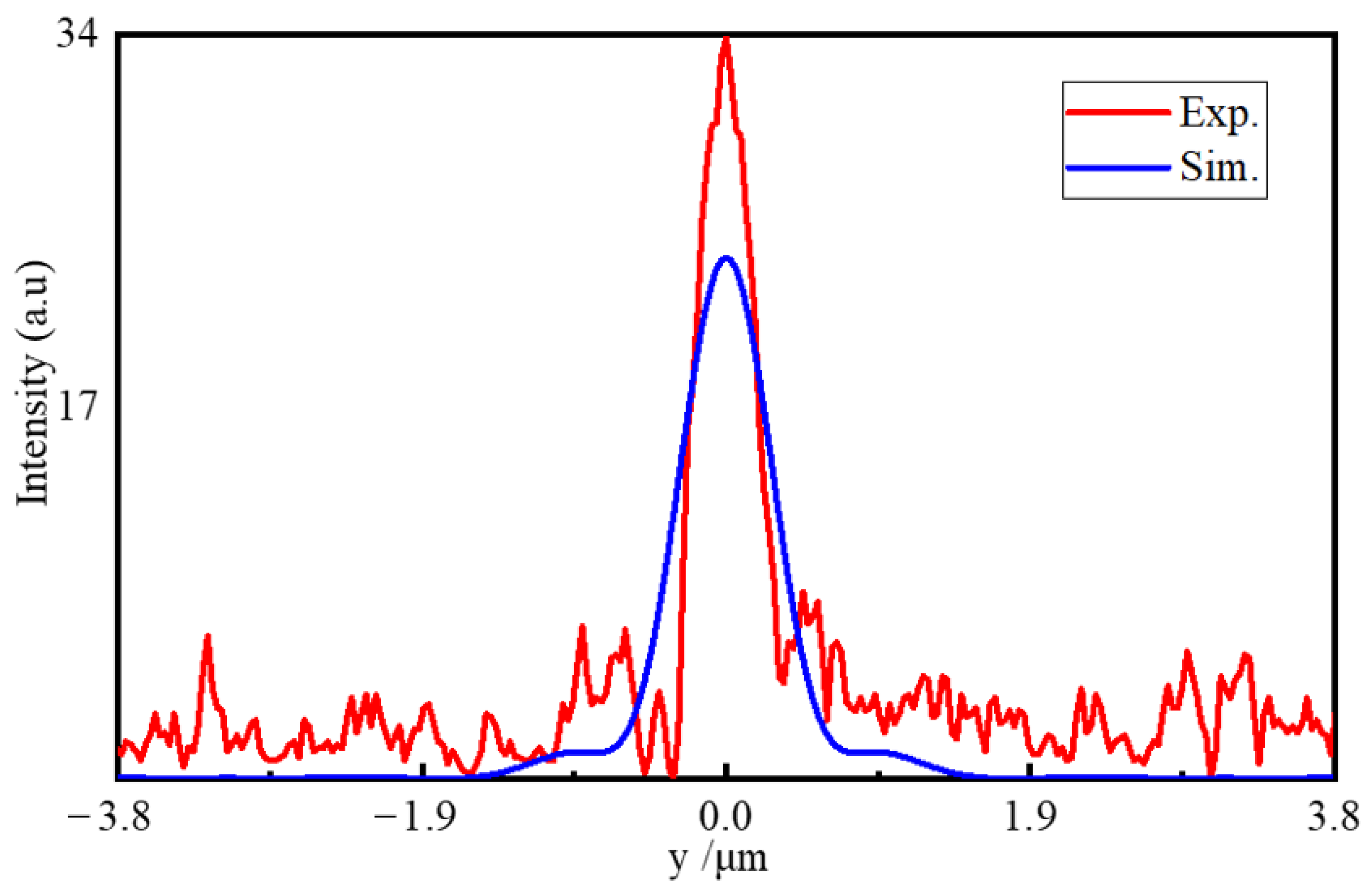
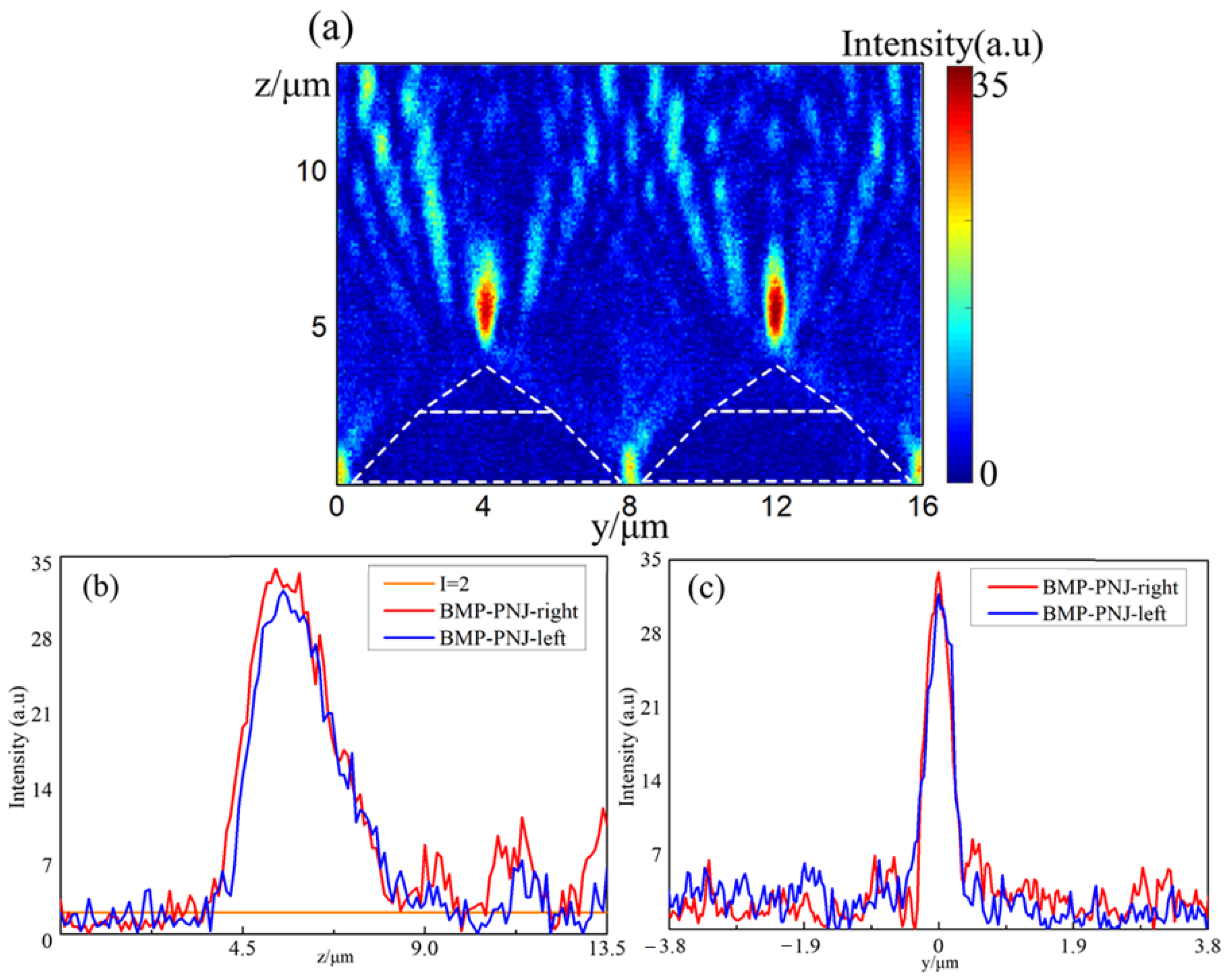
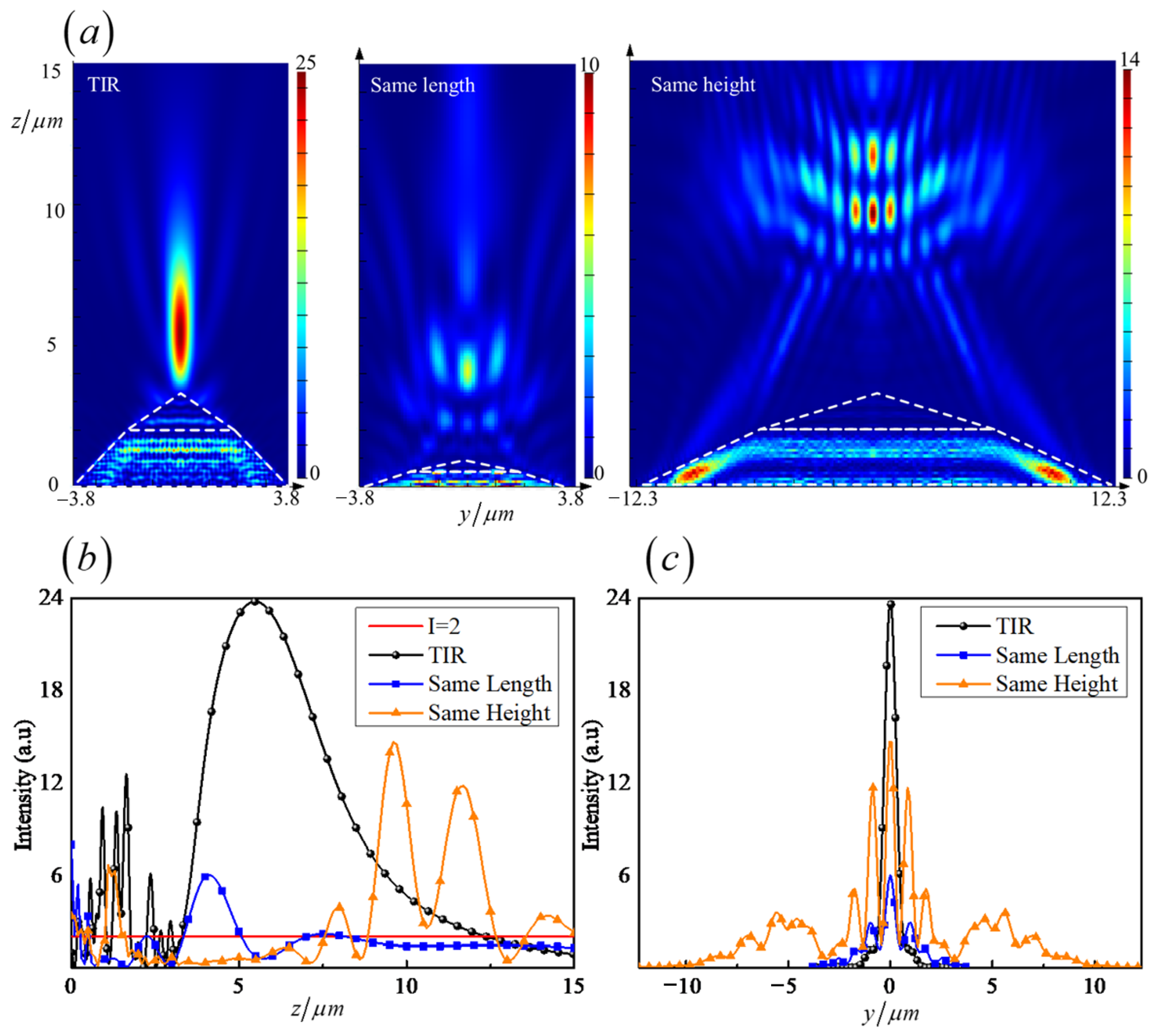
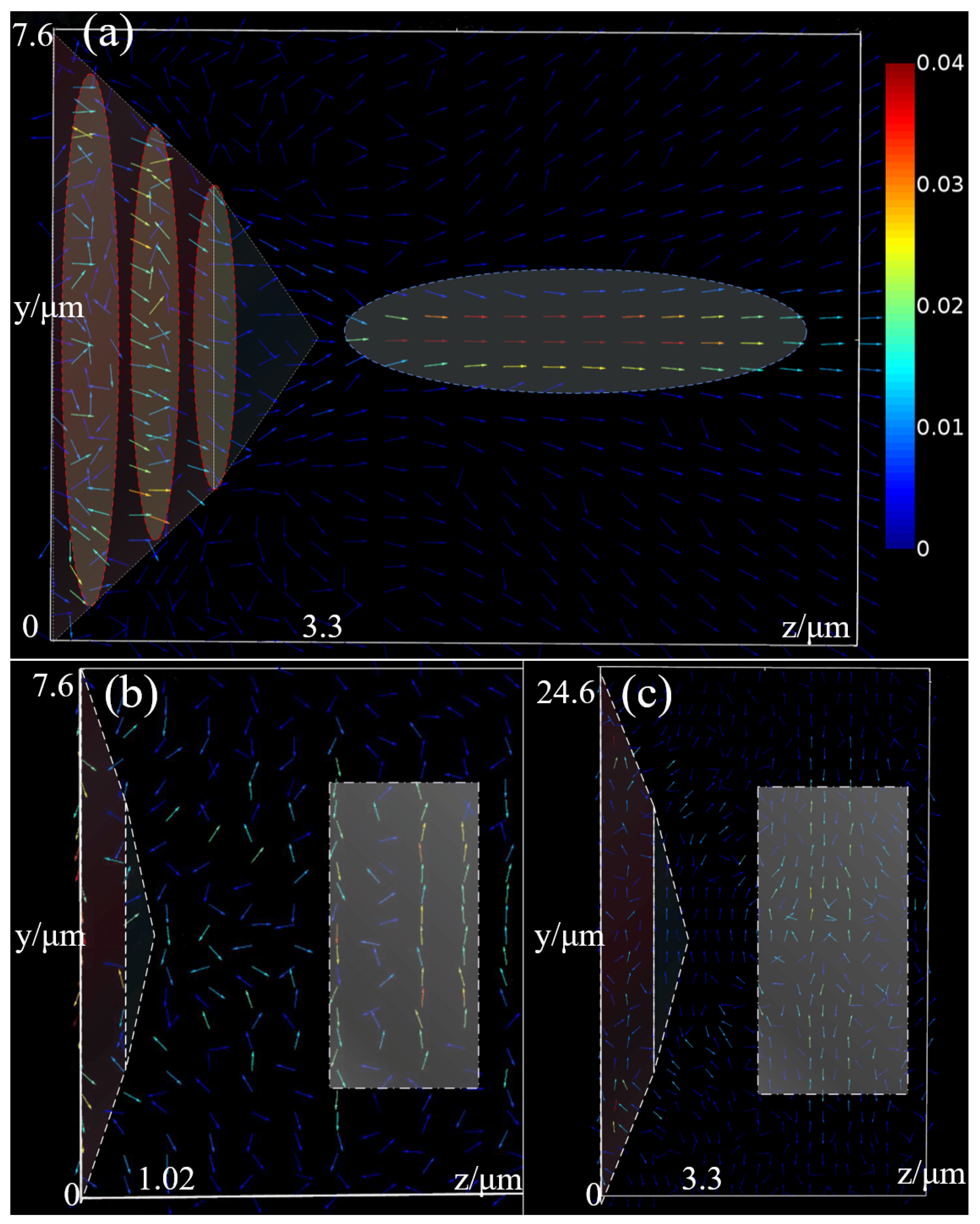
| Type | /μm | /μm | /μm | /μm | /° | TIR |
|---|---|---|---|---|---|---|
| TIR | 7.60 | 3.80 | 2.00 | 1.30 | 46.5 | Used |
| Same length | 7.60 | 3.80 | 0.62 | 0.40 | 18.0 | Not used |
| Same height | 24.60 | 12.3 | 2.00 | 1.30 | 18.0 | Not used |
| SiH4/Sccm | N2/Sccm | N2O/Sccm | Temperature/°C | RF Power/W | Pressure/Pa | Deposition Rate/nm·min−1 | |
|---|---|---|---|---|---|---|---|
| 1 | 120 | 0 | 60 | 250 | 30 | 220 | 64.9 |
| 2 | 40 | 103 | 0 | 250 | 270 | 67 | 21.3 |
| SF6/Sccm | C4F8/Sccm | ICP/W | RF/W | Pressure/mTorr | Etching Rate /nm·min−1 | Ratio of Etch Rates/Resist:SiNx:SiO2 | |||
|---|---|---|---|---|---|---|---|---|---|
| Resist | SiNx | SiN2 | |||||||
| 1 | 45 | 7 | 500 | 20 | 15 | 312.5 | 221.0 | 84.0 | 1.4:1:0.38 |
| 2 | 0 | 7 | 1000 | 100 | 0.8 | 283.0 | 228.0 | 215.0 | 1.2:1:0.94 |
| /m | /m | /m | /m | /m | |||||
|---|---|---|---|---|---|---|---|---|---|
| Simulation | 7.60 | 3.80 | 0 | 2.00 | 1.30 | 2.02 | 0 | 1.458 | 0 |
| Experiment | 7.61 | 3.81 | 0.78 | 2.03 | 1.32 | 2.04 | 2.2 × 10−5 | 1.462 | 1.6 × 10−5 |
| Type | /(a.u) | L/ | w/ | f/ |
|---|---|---|---|---|
| Simulation | 23.8 | 14.2 | 1.0 | 3.4 |
| BMP-PNJ-right | 33.8 | 10.1 | 0.6 | 3.0 |
| BMP-PNJ-left | 31.8 | 9.6 | 0.4 | 3.4 |
| Type | /(a.u) | L/ | w/ | f/ |
|---|---|---|---|---|
| TIR | 23.80 | 14.22 | 1.00 | 3.40 |
| Same length without TIR | 6.03 | 6.21 | 0.95 | 4.81 |
| Same height without TIR | 14.70 | 5.78 | 1.91 | 9.80 |
Publisher’s Note: MDPI stays neutral with regard to jurisdictional claims in published maps and institutional affiliations. |
© 2021 by the authors. Licensee MDPI, Basel, Switzerland. This article is an open access article distributed under the terms and conditions of the Creative Commons Attribution (CC BY) license (https://creativecommons.org/licenses/by/4.0/).
Share and Cite
Ge, S.; Liu, W.; Zhang, J.; Huang, Y.; Xi, Y.; Yang, P.; Sun, X.; Li, S.; Lin, D.; Zhou, S.; et al. Novel Bilayer Micropyramid Structure Photonic Nanojet for Enhancing a Focused Optical Field. Nanomaterials 2021, 11, 2034. https://doi.org/10.3390/nano11082034
Ge S, Liu W, Zhang J, Huang Y, Xi Y, Yang P, Sun X, Li S, Lin D, Zhou S, et al. Novel Bilayer Micropyramid Structure Photonic Nanojet for Enhancing a Focused Optical Field. Nanomaterials. 2021; 11(8):2034. https://doi.org/10.3390/nano11082034
Chicago/Turabian StyleGe, Shaobo, Weiguo Liu, Jin Zhang, Yuetian Huang, Yingxue Xi, Pengfei Yang, Xueping Sun, Shijie Li, Dabin Lin, Shun Zhou, and et al. 2021. "Novel Bilayer Micropyramid Structure Photonic Nanojet for Enhancing a Focused Optical Field" Nanomaterials 11, no. 8: 2034. https://doi.org/10.3390/nano11082034
APA StyleGe, S., Liu, W., Zhang, J., Huang, Y., Xi, Y., Yang, P., Sun, X., Li, S., Lin, D., Zhou, S., Zhu, Y., Li, W., & Yu, Y. (2021). Novel Bilayer Micropyramid Structure Photonic Nanojet for Enhancing a Focused Optical Field. Nanomaterials, 11(8), 2034. https://doi.org/10.3390/nano11082034








